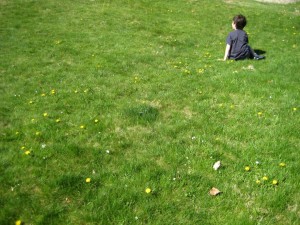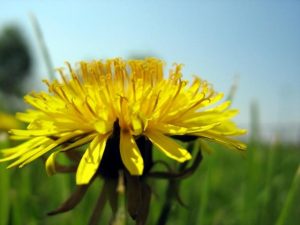It’s the very definition of springtime: the cheerful sight of a robin pulling a worm out of the new green grass. But the robin who goes worm-hunting on a well-tended lawn may be bringing more than a tasty meal home to his youngsters. If the lawn has been treated with a pesticide, the robin and his family may become statistics.
It’s been estimated by the Audubon Society that more than seven million wild birds are killed by the aesthetic use of lawn pesticides in the United States, every year. Aesthetic use: that doesn’t mean agricultural pesticides to grow food crops. That means the use of pesticides to make our lawns and gardens look nice.
Seven million wild birds, dead. To get rid of, among other things, dandelions.
What if a bird-lover puts up a feeder on a lawn that has been treated with herbicide for dandelions? People enjoy seeing sparrows and chickadees hopping around on the grass, pecking at seeds. But they don’t see what happens after the birds fly away. Our knowledge of pesticides’ effects on birds is like a pyramid-shaped iceberg, in which the widest portion by far remains unseen. Only a few dead birds are noticed and collected, but it’s probable that the majority of bird deaths caused by pesticides go undetected.
Pesticides are poisons. They kill living things. On every package there is the number of a poison control center, or instructions to physicians. Obviously, if you drink the pesticide, it’s a threat to your health. But even if you follow the directions and apply the pesticide precisely as instructed by the manufacturer, pesticides kill things. Dandelions, but also robins. Weeds, but also butterflies, cardinals, song sparrows, chickadees, dogs, cats, ladybugs, bluebirds, meadowlarks…
And children? Children have long been identified as being especially vulnerable to pesticide exposure. Their developing bodies are at greater risk from toxins. Also, they don’t sit in chairs on the deck, sip iced tea, and merely gaze at the lawn. Children play on lawns: they roll down the hill, lie on the grass, chew grass blades, blow dandelion puffballs. Like the robins and the neighborhood dogs and cats, they can’t read the little signs with the tiny letters warning that this lawn has been treated with herbicides.
A lawn that has been drenched with pesticide looks like any other lawn, pretty much. Pesticides are more or less invisible: they have no strong smell, there’s little sign of their presence. How can I tell which lawn I can let my child play on? Where can a robin get a worm to bring home to the nestlings? What’s a parent to do?
Seems like there should be some sort of marker, a badge of safety, a brightly-colored seal of approval on the grass of organic lawns. Something easy to spot, scattered across the grass to tell children that this field is safe to play on, this hill is safe to roll down. Some signpost should promise that the worms that a robin pulls out of this lawn won’t bring slow death to baby robins; the dog who plays catch on this grass won’t be at risk for neurological damage; walking barefoot on this lawn won’t bring a higher risk of leukemia to my toddler.
Well, there is such a marker, and it’s bright yellow. 
For more on dandelions, check out my book Teeth of the Lion: The Story of the Beloved and Despised Dandelion.
For more info and alternatives see: what is round-up round-up alternatives





Anita, we must be on the same wavelength again! Thanks so much for speaking out about this!!!